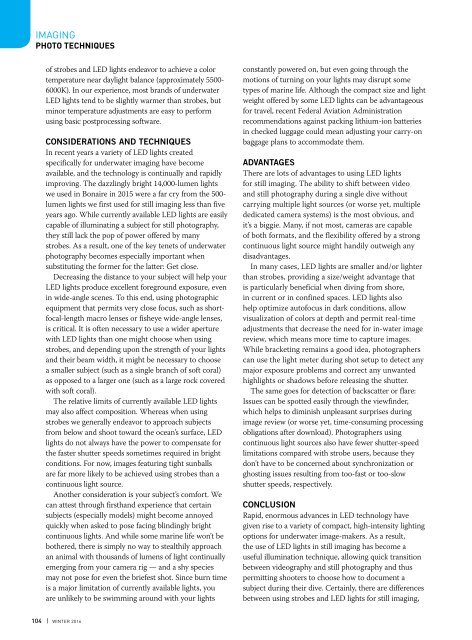AD 2016 Q1
Create successful ePaper yourself
Turn your PDF publications into a flip-book with our unique Google optimized e-Paper software.
IMAGING<br />
PHOTO TECHNIQUES<br />
of strobes and LED lights endeavor to achieve a color<br />
temperature near daylight balance (approximately 5500-<br />
6000K). In our experience, most brands of underwater<br />
LED lights tend to be slightly warmer than strobes, but<br />
minor temperature adjustments are easy to perform<br />
using basic postprocessing software.<br />
CONSIDERATIONS AND TECHNIQUES<br />
In recent years a variety of LED lights created<br />
specifically for underwater imaging have become<br />
available, and the technology is continually and rapidly<br />
improving. The dazzlingly bright 14,000-lumen lights<br />
we used in Bonaire in 2015 were a far cry from the 500-<br />
lumen lights we first used for still imaging less than five<br />
years ago. While currently available LED lights are easily<br />
capable of illuminating a subject for still photography,<br />
they still lack the pop of power offered by many<br />
strobes. As a result, one of the key tenets of underwater<br />
photography becomes especially important when<br />
substituting the former for the latter: Get close.<br />
Decreasing the distance to your subject will help your<br />
LED lights produce excellent foreground exposure, even<br />
in wide-angle scenes. To this end, using photographic<br />
equipment that permits very close focus, such as shortfocal-length<br />
macro lenses or fisheye wide-angle lenses,<br />
is critical. It is often necessary to use a wider aperture<br />
with LED lights than one might choose when using<br />
strobes, and depending upon the strength of your lights<br />
and their beam width, it might be necessary to choose<br />
a smaller subject (such as a single branch of soft coral)<br />
as opposed to a larger one (such as a large rock covered<br />
with soft coral).<br />
The relative limits of currently available LED lights<br />
may also affect composition. Whereas when using<br />
strobes we generally endeavor to approach subjects<br />
from below and shoot toward the ocean’s surface, LED<br />
lights do not always have the power to compensate for<br />
the faster shutter speeds sometimes required in bright<br />
conditions. For now, images featuring tight sunballs<br />
are far more likely to be achieved using strobes than a<br />
continuous light source.<br />
Another consideration is your subject’s comfort. We<br />
can attest through firsthand experience that certain<br />
subjects (especially models) might become annoyed<br />
quickly when asked to pose facing blindingly bright<br />
continuous lights. And while some marine life won’t be<br />
bothered, there is simply no way to stealthily approach<br />
an animal with thousands of lumens of light continually<br />
emerging from your camera rig — and a shy species<br />
may not pose for even the briefest shot. Since burn time<br />
is a major limitation of currently available lights, you<br />
are unlikely to be swimming around with your lights<br />
constantly powered on, but even going through the<br />
motions of turning on your lights may disrupt some<br />
types of marine life. Although the compact size and light<br />
weight offered by some LED lights can be advantageous<br />
for travel, recent Federal Aviation Administration<br />
recommendations against packing lithium-ion batteries<br />
in checked luggage could mean adjusting your carry-on<br />
baggage plans to accommodate them.<br />
<strong>AD</strong>VANTAGES<br />
There are lots of advantages to using LED lights<br />
for still imaging. The ability to shift between video<br />
and still photography during a single dive without<br />
carrying multiple light sources (or worse yet, multiple<br />
dedicated camera systems) is the most obvious, and<br />
it’s a biggie. Many, if not most, cameras are capable<br />
of both formats, and the flexibility offered by a strong<br />
continuous light source might handily outweigh any<br />
disadvantages.<br />
In many cases, LED lights are smaller and/or lighter<br />
than strobes, providing a size/weight advantage that<br />
is particularly beneficial when diving from shore,<br />
in current or in confined spaces. LED lights also<br />
help optimize autofocus in dark conditions, allow<br />
visualization of colors at depth and permit real-time<br />
adjustments that decrease the need for in-water image<br />
review, which means more time to capture images.<br />
While bracketing remains a good idea, photographers<br />
can use the light meter during shot setup to detect any<br />
major exposure problems and correct any unwanted<br />
highlights or shadows before releasing the shutter.<br />
The same goes for detection of backscatter or flare:<br />
Issues can be spotted easily through the viewfinder,<br />
which helps to diminish unpleasant surprises during<br />
image review (or worse yet, time-consuming processing<br />
obligations after download). Photographers using<br />
continuous light sources also have fewer shutter-speed<br />
limitations compared with strobe users, because they<br />
don’t have to be concerned about synchronization or<br />
ghosting issues resulting from too-fast or too-slow<br />
shutter speeds, respectively.<br />
CONCLUSION<br />
Rapid, enormous advances in LED technology have<br />
given rise to a variety of compact, high-intensity lighting<br />
options for underwater image-makers. As a result,<br />
the use of LED lights in still imaging has become a<br />
useful illumination technique, allowing quick transition<br />
between videography and still photography and thus<br />
permitting shooters to choose how to document a<br />
subject during their dive. Certainly, there are differences<br />
between using strobes and LED lights for still imaging,<br />
104 | WINTER <strong>2016</strong>









